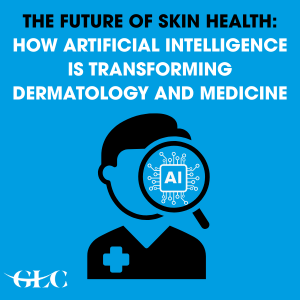Free knowledge to monitor the world of events. Have a look at our must read Blogs on Pharma, Finance, HR, Health and Cross Industry.
The Future of Skin Health: How Artificial Intelligence is Transforming Dermatology and Medicine
2022-08-16
This blog talks about how artificial intelligence is revolutionizing dermatology and medicine, outlining its history, current applications, challenges, and opportunities.
Artificial Intelligence (AI) has revolutionized numerous industries, and medicine is at the forefront of this transformation. Particularly, dermatology, with its image-oriented nature, is emerging as one of the most promising frontiers for AI exploration. Although AI in dermatology remains in its early stages when compared to radiology, the potential of AI to transform skin disease diagnosis and management cannot be ruled out.

What is Artificial Intelligence?
The Association for the Advancement of Artificial Intelligence (AAAI) defines AI as "the scientific understanding of mechanisms underlying thought and intelligent behavior and their embodiment in machines." In essence, AI is computer software that attempts to mimic human intellectual processes like learning, reasoning, and problem-solving.
Key AI Terms in Dermatology:
- Machine Learning (ML): One of the areas of AI wherein machines are trained from data without direct programming.
- Deep Learning: A type of ML that uses artificial neural networks with many layers to process large sets of data.
- Artificial Neural Networks (ANN): Models inspired by the human brain, capable of detecting complex patterns in data.
A Brief History of AI in Medicine
- 1956: The term Artificial Intelligence was coined at Dartmouth College.
- 1970s: Early AI applications in life sciences appeared, but limited computing power restricted widespread use.
- 2010s onward: Advancements in computing enabled AI to expand across various medical fields, including dermatology.
Why Dermatology is Ideal for AI
Dermatology is a visual specialty. Diagnosing conditions like melanoma, psoriasis, and atopic dermatitis often involves analyzing clinical, dermatoscopic, and histopathological images. This makes it well-suited for AI algorithms that excel at pattern recognition.
Key Applications of AI in Dermatology
- Skin Cancer Detection
Landmark research has demonstrated that AI can match, if not beat, the diagnostic ability of dermatologists in identifying skin cancers:
- Stanford University (2017): A deep learning system that was trained on 129,450 images accurately classified skin cancer at a level comparable to 21 board-certified dermatologists.
- Fujisawa et al. (2019): Achieved a 96.3% sensitivity and 89.5% specificity for skin cancer classification from a relatively modest dataset.
- Han et al. (2018, China): Had good performance in classifying 12 skin conditions, though there was rather limited external validation.
- Brinker et al. (2019): Showed AI outperformed dermatologists in classifying dermoscopic images of melanomas and nevi.
- Mobile AI Apps for Skin Screening
Several smartphone apps offer to screen for skin cancer, but studies produce conflicting results. For example, sensitivities range from 7% to 73%, so current consumer apps are not yet ready to substitute expert evaluation.
- Histopathological Image Analysis
Artificial intelligence may also be used to analyze biopsy slides. Hekler et al. (2019) have demonstrated that a neural network was capable of surpassing histopathologists in identifying melanoma on histology slides.
- Other Dermatological Conditions
- Atopic Dermatitis: AI algorithms help identify patients from electronic health records and annotate images of affected skin.
- Psoriasis: AI helps predict disease risk using genetic information and clinical images with up to 99.8% prediction accuracy.
- Onychomycosis: AI models trained on nail images outperformed dermatologists in diagnosing fungal infections.
Benefits of AI in Dermatology and Medicine
- Prompt and Accurate Diagnosis: Reduces diagnostic error and enables timely treatment.
- Remote Skin Care Access: Tele dermatology software enables consultations in remote locations.
- Efficient Workflow: AI assists dermatologists by performing repetitive image analysis.
- Customized Treatment: AI software recommends treatment plans based on patient profiles.
Challenges to AI Dermatology Applications
- Limited and Non-diverse Data Sets: AI models are built on lighter skin tones, and accuracy thus lowers in darker skin tones.
- Multidisciplinary Cooperation Needed: There needs to be cooperation between dermatologists, engineers, and data scientists for better solutions.
- Ethical and Legal Issues: Privacy of data, algorithms' bias, and medico-legal accountability are key issues.
- Interaction with Clinical Data: Dermatological diagnosis also includes patient history, lifestyle factors, and not just images.
The Future of AI in Dermatology: What's Next?
Governments and the tech world are putting massive investments into AI. As it keeps evolving, get ready to witness:
- More intelligent diagnostic equipment is incorporated into dermatology clinics.
- AI algorithms learn from international datasets to enhance precision in all skin types.
- Better tele-dermatology platforms are increasing the accessibility of skin care.
- Personalized skincare advice developed with AI analysis of environmental conditions, genetics, and lifestyle.
Conclusion: Embracing the AI Revolution in Dermatology
Artificial intelligence is revolutionizing dermatology by making the treatment and diagnosis of skin ailments better. It will not replace dermatologists but augment their knowledge and make dermatological treatment faster, more accurate, and more accessible.
Healthcare providers and dermatologists need to stay updated with AI technology in order to use this groundbreaking tool for maximum advantage. They can then offer wiser, more equitable, and individualized skin care to patients.
Do you want to understand more? Join our upcoming AI in Dermatology and Medicine Masterclass.
By Shara Najimudeen, Digital Marketing Executive, GLC Europe, Colombo Office, Sri Lanka.
Get a feel for our events

Training Program for CMC Leaders - EU edition
27th October 2025 - 16th January 2026
Rich with practical insights and real-world applications
learn more >>
Training Program for CMC Leaders - US edition
27th October 2025 - 16th January 2026
Rich with practical insights and real-world applications
learn more >>
Mastering the Common Technical Document (CTD) for Biologics Masterclass - EU edition
12-16 January, 2026
From guidelines to submissions
learn more >>














